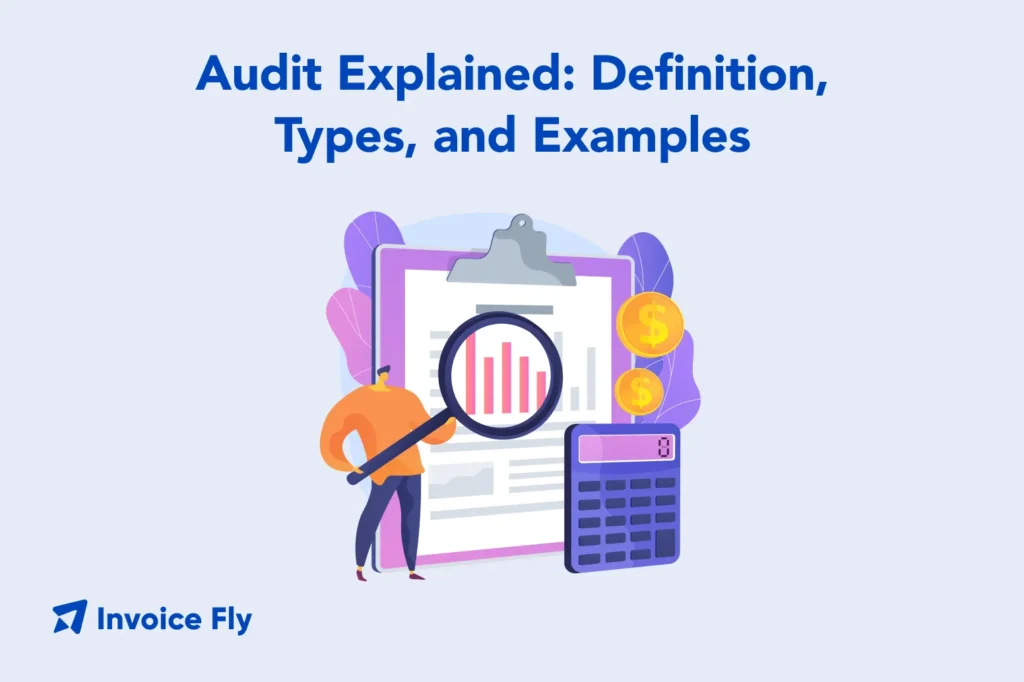Audit Explained: Definition, Types, and Examples

Table of Contents
Audit meaning: an audit is a formal, independent check of a company’s financial records, processes, or operations to make sure information is accurate, complete, and compliant with rules. Understanding what audit means helps owners, managers, and teams spot risks early, improve internal control, and build trust with investors, lenders, and customers.
In this guide, you’ll learn what does audit mean, the main types of audits, key concepts like audit risk and PBC, the audit process step by step, and practical examples. We’ll keep it clear and useful for small businesses and growing teams.
What Is an Audit?
According to the U.S. Department of Justice Office of Justice Programs, an audit is a systematic examination of financial records and supporting documents to determine whether recorded information properly reflects the organization’s actual financial operations.
In simple business terms, auditing means a structured review performed by trained professionals (auditors) to evaluate whether financial statements, internal controls, or business processes are accurate, well controlled, and working as intended.
Depending on scope, an audit might examine your income statement, balance sheet, cash flow, inventory, payroll, tax returns, or operational procedures. Audits are not only about finding mistakes — a well-run audit highlights process improvements, cost savings, and compliance gaps so you can fix issues before they become bigger problems.
Who relies on audits in business
- Owners and boards rely on audits for assurance that reports are reliable.
- Investors and lenders look for audited financial statements before funding.
- Regulators and tax agencies use audits to confirm compliance.
- Managers use audit results to strengthen controls and improve performance.
Audits vs. reviews vs. compilations
- Audit: Highest level of assurance; includes testing and evidence gathering by independent auditors.
- Review: Limited assurance using inquiries and analytics; no detailed testing.
- Compilation: No assurance; simply presenting your data in financial statement format.

Why Audits Matter in Business
Audits make a difference in how well your company runs and how much trust others place in it.
- Accuracy: Catch misstatements in revenue, expenses, assets, and liabilities before they mislead stakeholders.
- Compliance: Confirm you follow tax rules, labor laws, and industry standards to avoid penalties.
- Risk management: Identify weak controls that could lead to fraud, errors, or losses.
- Process improvement: Reveal bottlenecks, duplicate work, or training gaps that slow down operations.
- Trust and transparency: Verified reporting strengthens credibility with customers, partners, and lenders.
Real-world examples of audits
Lisa’s manufacturing business needed a bank loan to expand. Her lender required audited financial statements. The audit confirmed accurate revenue, inventory, and receivables—resulting in loan approval at a favorable rate.
David’s healthcare clinic struggled with billing errors. An internal audit found staff were duplicating data entry. After following the audit’s recommendations, billing errors dropped 40% and staff saved two hours daily.
Quick win! Clear reporting builds confidence. Create simple dashboards and share updates with Business reports to keep stakeholders informed throughout the year. To understand how audit results tie to your performance, track metrics using your profit and loss statement and compare insights in gross profit vs net profit.
Types of Audits
Different audits answer different questions. Here are the main categories you’ll encounter in business.
| Type of Audit | Focus | Performed By | Goal / Outcome | Key Details & Examples |
| Financial Audit | Balance sheet, income statement, and cash flow accuracy | Independent CPA firms | Provides assurance statements are free from material errors. Issues opinion: unmodified (clean), qualified, adverse, or disclaimer. | Verifies journal entries and accrual basis accounting. Ensures GAAP compliance. |
| Internal Audit | Operational efficiency, risk management, internal controls | Internal audit team reporting to board | Improves processes, strengthens controls, and ensures policies are followed. | Reviews payroll, IT access, HR, data privacy, and compliance. Helps detect fraud or process gaps. |
| Tax Audit | Tax compliance and reporting accuracy | Tax authorities (IRS, state agencies) | Confirms income and deductions are properly reported. | Triggered by mismatched forms, high deductions, or random selection. |
| Operational & Compliance Audit | Process efficiency and regulatory adherence | Internal teams or external specialists | Identify weaknesses and reduce compliance risk. |
Key Audit Concepts Explained
Learning a few core ideas makes audit meaning clearer and reduces confusion during the process.
Audit risk
The meaning of audit risk is the chance an auditor gives the wrong opinion—for example, stating the financial statements are accurate when they contain significant errors. Audit risk includes three components: inherent risk (complexity that makes errors more likely), control risk (the chance internal control won’t catch errors), and detection risk (the chance audit tests won’t catch remaining issues).

Pervasive issues
Pervasive meaning in audit refers to problems so widespread they affect many parts of the financial statements or the statements as a whole. These pervasive problems often lead to qualified, adverse, or disclaimer opinions rather than clean audit reports.
Auditability meaning
Auditability meaning refers to how easy it is to audit your business. Good documentation, clear trails from invoice to ledger balance, consistent processes, and organized records improve auditability and reduce both audit cost and time.
PBC (Provided By Client) meaning in audits
PBC meaning audit refers to documents the client prepares and provides to auditors: trial balance, bank statements, journal entries, contracts, invoices, payroll reports, inventory listings, policies, and more. The PBC audit meaning is critical because a good PBC list speeds up the audit and prevents delays.

The Audit Process: Step by Step
The Department of Labor Office of Inspector General outlines standard audit procedures that most audits follow. Here’s what to expect:
- Engagement & planning: Define scope, timeline, and responsibilities. Auditors perform risk assessment to decide testing focus areas.
- PBC request: You receive a list of documents to provide. Organize files by area: cash, revenue, expenses, payroll, inventory, fixed assets, and legal.
- Walkthroughs & controls review: Auditors learn your key processes and identify controls like approvals, reconciliations, segregation of duties, and access rights.
- Testing: Auditors verify controls work as designed and sample transactions to confirm accuracy. They reconcile accounts, confirm balances with third parties, and review supporting documentation.
- Evaluation of findings: Auditors assess whether errors are material and discuss proposed adjustments and recommendations with management.
- Audit report & close-out: External auditors issue an opinion. Internal auditors provide findings with risk ratings and action plans. Management responds with timelines to address issues.

Examples of Audits
Financial audit for expansion: A contractor needed equipment financing. The lender required audited statements. The audit confirmed accurate revenue recognition, solid contractor cash flow management, and reliable receivables. Result: approved credit line at a competitive rate.
Internal audit of inventory: A retailer had stock discrepancies. The audit introduced barcode scanning, raising inventory accuracy from 82% to 96%.
Tax audit for deductions: A consultant reported high home-office expenses. When asked for proof, she provided receipts and expense reports — most deductions were accepted.
Compliance audit for federal grant: A nonprofit underwent audit of federal funds. Results improved expense tracking and documentation.
Conclusion About Audits
Understanding what being audited means in business helps you treat audits as valuable health checks rather than stressful ordeals. Whether it’s a financial audit that reassures investors, an internal audit that tightens operational controls, a tax audit that confirms compliance, or an operational audit that streamlines processes—the goal of the observation remains the same: accurate information, strong controls, and better strategic decisions.
Build auditability into everyday work by closing books monthly with proper small business bookkeeping practices, maintaining clear documentation, and organizing your PBC files as you go. Review your profit and loss statement and gross profit vs net profit regularly to catch issues early. When you do this consistently, your next audit will be faster, smoother, and more useful—freeing up management time to focus on growing the business instead of scrambling for documents.
Share documents securely with auditors using a Client Portal and generate clean documentation with our Invoice Generator.
FAQs about Audits
To provide assurance that financial statements are fairly presented, controls work, and processes comply with laws or policies. Audits also highlight improvements and risks.
Not if your records are accurate and organized. What does being audited mean in practice? It's a common business process. Keep clear documentation, respond promptly, and ask your auditor or tax advisor questions when you are unsure.
It varies by jurisdiction and year. Risk factors can include mismatched forms (like 1099s), unusually high deductions, cash-intensive businesses, and complex transactions.
Inherent risk, control risk, and detection risk. Together, they form overall audit risk—the chance of an incorrect audit opinion.
You'll receive findings and, for external audits, an opinion. Management should create an action plan to fix issues, set deadlines, and monitor progress.
Large unexplained changes, missing documentation, inconsistent accounting policies, weak internal controls, and round-number patterns in entries can all draw attention.
